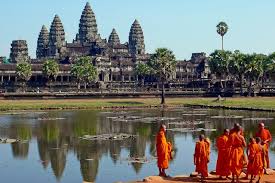Angkor Wat, the largest religious monument in the world, stands as a symbol of Cambodia’s rich cultural heritage and ancient grandeur. Nestled in the heart of the Cambodian jungle, this architectural marvel is not only a testament to the ingenuity of the Khmer Empire but also a captivating destination for travelers and historians alike. In this comprehensive guide, we will delve into the mysteries of Angkor Wat, exploring its history, architecture, significance, and tips for visiting this awe-inspiring site in 2024.
1. The Historical Significance of Angkor Wat

Built in the early 12th century by King Suryavarman II, Angkor Wat originally served as a Hindu temple dedicated to the god Vishnu. Over the centuries, it transformed into a Buddhist temple, reflecting the region’s evolving religious landscape. This majestic structure was designed to represent an earthly model of the cosmic world, with its layout mirroring the universe’s spiritual and physical dimensions.
Angkor Wat’s construction spanned approximately 30 years, showcasing the architectural brilliance and dedication of the Khmer Empire. The temple complex covers an area of over 162 hectares (402 acres) and is renowned for its intricate bas-reliefs and towering spires.
2. Architectural Wonders of Angkor Wat
Angkor Wat’s architecture is a marvel of ancient engineering and artistry. The temple is characterized by its five central towers, symbolizing Mount Meru, the center of the universe in Hindu and Buddhist cosmology. The towers are surrounded by four rectangular galleries, each representing the mountain’s surrounding mountain ranges and oceans.
The temple’s walls are adorned with detailed bas-reliefs and carvings depicting scenes from Hindu mythology, including the famous Churning of the Ocean of Milk. The level of detail and craftsmanship in these artworks provides a glimpse into the rich cultural and religious beliefs of the Khmer people.
3. The Mysteries and Legends of Angkor Wat
Angkor Wat is enveloped in a veil of legends and mysteries that add to its allure. One popular legend is that of the “hidden treasure” buried within the temple complex, said to be hidden by ancient Khmer kings to protect it from invaders. While no physical evidence of this treasure has been found, the legend continues to captivate visitors and treasure hunters.
Another intriguing aspect of Angkor Wat is the “mysterious disappearance” of the builders. Historical records suggest that the Khmer Empire’s sudden decline in the 15th century led to the abandonment of Angkor Wat. However, the exact reasons for this decline and the fate of its builders remain subjects of speculation and research.
4. Visiting Angkor Wat: Tips for Travelers
When planning a visit to Angkor Wat in 2024, consider the following tips to make the most of your experience:
- Best Time to Visit: The ideal time to visit Angkor Wat is during the dry season, from November to April. This period offers cooler temperatures and less humidity, making for a more comfortable visit.
- Dress Code: As Angkor Wat is a religious site, it is important to dress modestly. Wear clothing that covers your shoulders and knees, and avoid revealing or tight-fitting attire.
- Guided Tours: To fully appreciate the historical and cultural significance of Angkor Wat, consider hiring a knowledgeable guide. Guided tours provide valuable insights and enhance your understanding of the temple’s history and architecture.
- Photography: Early morning and late afternoon are the best times for photography, as the soft light creates stunning effects on the temple’s stone carvings and provides excellent conditions for capturing sunrise and sunset views.
- Respect the Site: Be mindful of the sacred nature of Angkor Wat and follow local guidelines and regulations. Avoid touching or climbing on the temple’s structures and respect the religious practices of other visitors.
5. The Future of Angkor Wat: Preservation and Conservation
As a UNESCO World Heritage Site, Angkor Wat is subject to ongoing preservation and conservation efforts aimed at protecting its historical and cultural integrity. The Cambodian government, in collaboration with international organizations, is working to address challenges such as weathering, tourism impact, and structural deterioration.
In recent years, initiatives have focused on restoring damaged sections of the temple complex, improving visitor management, and promoting sustainable tourism practices. These efforts ensure that future generations can continue to marvel at the beauty and significance of Angkor Wat.
6. Conclusion: A Timeless Treasure

Angkor Wat remains one of the most breathtaking and enigmatic monuments in the world. Its architectural grandeur, historical significance, and the legends that surround it make it a must-visit destination for anyone interested in exploring the wonders of ancient civilizations. Whether you are a history buff, an architecture enthusiast, or simply a curious traveler, Angkor Wat offers an unforgettable journey into the heart of Cambodia’s cultural heritage.
Embark on your adventure to Angkor Wat and uncover the mysteries of this remarkable temple complex. As you wander through its majestic corridors and admire its intricate carvings, you will gain a deeper appreciation for the timeless beauty and historical significance of this iconic landmark



